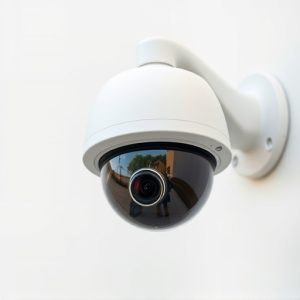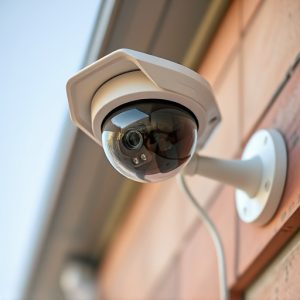Dummy Camera Height: Optimal Placement for Enhanced Security
Strategically place dummy security cameras at 5-10 feet (1.5-3m) above ground, adhering to the Dummy…….
Strategically place dummy security cameras at 5-10 feet (1.5-3m) above ground, adhering to the Dummy Security Camera Height Guidelines for optimal realism and deterrence. Mount them slightly above eye level (1.5-1.8m) for enhanced illusion and coverage without being too noticeable. Account for natural obstacles and ensure a clear line of sight to entry points. Regular cleaning and testing maintain visual authenticity, making them powerful tools in crime prevention.
“Uncover the strategic secrets behind effective dummy security camera placement with our comprehensive guide. Understanding the optimal Dummy Security Camera Height Guidelines is a game-changer for enhancing safety and deterring potential criminals. This article delves into the science behind choosing the right elevation, offering practical insights on installation best practices.
From analyzing factors influencing ideal positions to exploring the impact of realistic vs. unrealistic heights on crime rates, we provide essential knowledge for maximizing your surveillance strategy.”
- Understanding Dummy Security Camera Placement: Why Height Matters
- Guidelines for Optimal Dummy Camera Height: A Comprehensive Overview
- Factors Affecting the Ideal Position of a Fake Security Camera
- Best Practices for Installing and Maintaining Dummy Surveillance Equipment
- The Impact of Realistic vs. Unrealistic Dummy Camera Heights on Crime Deterrence
Understanding Dummy Security Camera Placement: Why Height Matters
When strategically placing dummy security cameras, understanding the Dummy Security Camera Height Guidelines is paramount for optimal effectiveness. The height at which a camera is positioned significantly impacts its field of view and overall surveillance capabilities. Generally, mounting cameras at eye level or slightly elevated ensures comprehensive coverage while avoiding any obstructions that might distort the image.
For instance, placing dummy cameras too low can lead to blind spots and limited visibility, whereas positioning them too high might result in distorted perspectives or blocked lines of sight. Adhering to these Dummy Security Camera Height Guidelines not only enhances security but also ensures a clear and accurate representation of the monitored area.
Guidelines for Optimal Dummy Camera Height: A Comprehensive Overview
To ensure maximum effectiveness and realism, establishing the optimal dummy security camera height is paramount. The ideal placement varies based on several factors, including building architecture, surveillance goals, and environmental conditions. A general rule of thumb recommends positioning dummy cameras at a height between 5 to 10 feet (approximately 1.5 to 3 meters) above ground level. This range offers a balanced view that mimics real camera coverage while remaining unobtrusive.
For more precise placement, consider the type of area being monitored. In high-traffic zones, placing dummy cameras slightly lower can enhance the illusion of constant observation. Conversely, in open spaces or areas requiring broader surveillance, raising the cameras slightly higher enhances their strategic advantage. Additionally, factoring in natural obstacles like trees or signage that might obstruct a real camera’s view ensures consistent and realistic simulation across various scenarios.
Factors Affecting the Ideal Position of a Fake Security Camera
The ideal position for a dummy or fake security camera is influenced by several factors, ensuring it serves its intended purpose as a deterrent and adds aesthetic value. One of the most crucial considerations is dummy security camera height. Generally, mounting the camera at eye level (approximately 5–6 feet or 1.5–1.8 meters) is recommended. This position mimics real security cameras, making them less noticeable to potential intruders while maintaining visibility for optimal deterrence.
Other factors include the camera’s view angle and placement in relation to entry points. Whether mounted on a pole, wall, or ceiling, the camera should have a clear line of sight without obstructions like trees, signs, or architectural elements that could block its view. This ensures maximum coverage and effectiveness as a surveillance tool, enhancing overall security measures.
Best Practices for Installing and Maintaining Dummy Surveillance Equipment
When installing dummy surveillance equipment, such as security camera housing units, adhering to best practices ensures optimal effectiveness and realism. Firstly, position your dummy cameras at a height that aligns with real security protocols. The Dummy Security Camera Height Guidelines typically suggest placing them at eye level or slightly elevated, mimicking actual camera placements. This strategic height enhances the realism of the setup, making it harder for potential intruders to identify the difference between active and dummy units.
Regular maintenance is equally crucial. Keep these devices clean and dust-free to maintain their visual authenticity. Periodically test the equipment’s functionality, ensuring the sensors and lights operate as expected. Simple adjustments like tightening connections and replacing batteries can significantly contribute to the overall realism of your surveillance setup, providing a more comprehensive security appearance.
The Impact of Realistic vs. Unrealistic Dummy Camera Heights on Crime Deterrence
The placement and appearance of security cameras play a significant role in crime deterrence, with dummy or fake cameras being an increasingly common deterrent. However, the effectiveness of these dummy security camera heights is heavily influenced by their realism. Studies show that deploying realistic dummy cameras at strategic locations can significantly reduce criminal activity. The sight of accurately modeled, functional-looking cameras discourages potential offenders, as it conveys a strong surveillance presence.
In contrast, unrealistic or poorly designed dummy cameras may not have the same impact. Inaccurate heights, obvious synthetic materials, and lack of detail can make them appear ineffectual. According to Dummy Security Camera Height Guidelines, positioning fake cameras at heights matching real cameras’ average placement can maximize their deterrence value. This strategy ensures a convincing visual representation, reinforcing the message that any attempted crime would be readily observable.
In conclusion, understanding the optimal dummy security camera height guidelines is paramount for effective crime deterrence. By considering factors like environment and intended effect, you can maximize the benefits of these devices. Remember that the right placement, along with proper installation and maintenance, ensures a robust security system that effectively discourages potential intruders.


